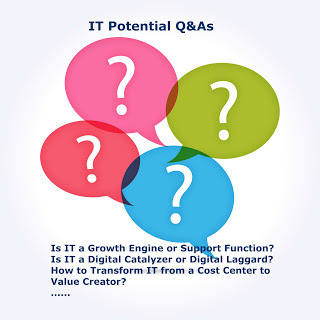Pearl Zhu's Blog, page 1236
April 16, 2017
The New Book “Digital IT - 100 Q&As” Chapter V Digital IT Potential Q&As
 Due to increasing speed of changes and overwhelming growth of information, forward-looking organizations across industrial sectors claim they are in the information management businesses, and there is a high expectation of IT to drive changes and lead the digital transformation. Hence, how to spur healthy debates for brainstorming how to run an innovative IT organization, how can IT contribute to customer acquisition and retention? How to run digital IT as a revenue rainmaker? And the payoff of IT digital transformation is not just for the quick win, but to build the long-term business competency.
Due to increasing speed of changes and overwhelming growth of information, forward-looking organizations across industrial sectors claim they are in the information management businesses, and there is a high expectation of IT to drive changes and lead the digital transformation. Hence, how to spur healthy debates for brainstorming how to run an innovative IT organization, how can IT contribute to customer acquisition and retention? How to run digital IT as a revenue rainmaker? And the payoff of IT digital transformation is not just for the quick win, but to build the long-term business competency.
Why is the CIO struggle to run IT as a better business partner: Traditional IT organizations are often run in the reactive mode, overloaded and understaffed, get stuck at the lower level of maturity. And IT leaders are perceived as the tech geek or tactical manager only. Digital CIOs have to enforce communication & collaboration with business partners and harness creativity. Without a clear strategy and a way to communicate it in the language of the business, CIOs will always have trouble getting even “aligned,” not mention of reaching the higher IT maturity level of proactively enabling and engaging with the business. The key challenge is to find a way so that both sides, even though they speak different languages can communicate effectively. CIOs must position themselves as the mentor to the business. They must have a higher level of influence on how businesses changes; for CIOs to be invited into the boardroom, they need to speak to the business about the strategic imperative of the organization.The true IT-business partnership is of course built over time, experiments more creative common language to communicate. As “lost in translation” is the key issue to separate IT from the business. It is worth the effort to take better communication approaches and be both creative and critical in enforcing business and IT collaboration. Business and IT have to work together to achieve their common goals and bring the long-term business results.
Should and how can IT get more engaged in revenue generating initiatives: Historically, IT has been perceived as a back office, a cost center, a technology controller, not an enabler. Now, with the accelerating speed of change and the consumerization of IT, IT needs to become an innovation engine and the driver of business growth. IT can drive the business, but it should be in conjunction with the business. Otherwise, IT will be seen as in competition with the business. IT has two sets of customers: the end customers IT can directly or indirectly serve or influence and the internal customers IT always works with. IT is the key ingredient of any competitive business capabilities, and IT can optimize the touch point of customers’ life experience. As always, IT also needs to work closely with internal customers to improve business operation. IT must partner with the respective business units to derive and deliver business strategies that are enabled or driven by IT. Also, more and more CIOs are taking on responsibilities outside of the IT domain, and in some cases with direct revenue generating responsibilities. If CIOs are perceived as business executives, they should be able to demonstrate revenue generating expertise.
 How to run a future-driven IT organization to catalyze growth: Traditional IT organizations spend a significant amount of time to “fixing the symptoms and keep the bottom line.” The future-driven IT needs to spend a significant amount of time on strategy management and innovation. IT is no longer just the tangible hardware boxes which are heading into the commodity, the future of IT is more about the intangible information fabric with digital lightweight technologies interwoven into your organization. IT needs to build up the new set of core capabilities in transforming itself and business as a whole. The future-driven IT is an innovation solution provider to help organizations deliver the best-tailored products or solutions to its end customers. The future-driven IT steps out of the traditional IT box, to understand the business and customers better via longer time frame; focuses on building core business capabilities to catalyze growth and improve overall business competency. The future-driven IT organizations need to continually fine-tune a successful structure to improve customer-centricity as well. The challenge for any business is to find a successful, often the hybrid structure that helps to empower people, enforce iterative communication, and cross-functional collaboration to deliver the better business result.
How to run a future-driven IT organization to catalyze growth: Traditional IT organizations spend a significant amount of time to “fixing the symptoms and keep the bottom line.” The future-driven IT needs to spend a significant amount of time on strategy management and innovation. IT is no longer just the tangible hardware boxes which are heading into the commodity, the future of IT is more about the intangible information fabric with digital lightweight technologies interwoven into your organization. IT needs to build up the new set of core capabilities in transforming itself and business as a whole. The future-driven IT is an innovation solution provider to help organizations deliver the best-tailored products or solutions to its end customers. The future-driven IT steps out of the traditional IT box, to understand the business and customers better via longer time frame; focuses on building core business capabilities to catalyze growth and improve overall business competency. The future-driven IT organizations need to continually fine-tune a successful structure to improve customer-centricity as well. The challenge for any business is to find a successful, often the hybrid structure that helps to empower people, enforce iterative communication, and cross-functional collaboration to deliver the better business result.
IT needs to shift from inside-out operation driven to outside-in customer centric. IT can become known as a revenue rainmaker by associating its efforts directly with sources of income. To unleash IT as well as the entire organization’s digital potential, CIOs have to be an integral part of the top leadership team for driving business value, bring technology vision in strategy making. IT leaders have to be hand-in-glove with the other business executives to map out the vision, put the framework in place to map the strategic objective into KPIs and then determine what technology investments will accelerate the changes and improve business profits, and IT needs to become the business catalyst, rather than just a supporting function.
Follow us at: @Pearl_Zhu
Published on April 16, 2017 21:52
April 15, 2017
The Monthly “Decision Master” Book Tuning: Digital Decision-Making Dots Connection Apr. 2017
The purpose of human decision making is to frame the right questions and validate the assumptions.
 Decision Masters refer to the digital leaders or professionals who can leverage multidimensional thought processes, information and intuition, take a step-wise scenario for making effective decisions consistently. Decision Masters also refer to the businesses or organizations that follow a set of well-defined principles, leverage fine-tuned decision processes, efficient information management system, decision frameworks, tools, and metrics to enable people across the organization making effective decisions collaboratively.
Decision Masters refer to the digital leaders or professionals who can leverage multidimensional thought processes, information and intuition, take a step-wise scenario for making effective decisions consistently. Decision Masters also refer to the businesses or organizations that follow a set of well-defined principles, leverage fine-tuned decision processes, efficient information management system, decision frameworks, tools, and metrics to enable people across the organization making effective decisions collaboratively.
Digital Decision-Making Dot Connection
Performance Management vs. Decision Management? Enterprise performance management is about how the organization manages performance— STRATEGIC and OPERATIONAL plans, METRICS, day-to-day decisions structurally. Business decision management is how the organization leverage tools, systems, and people to weigh in varying factors for improving decision effectiveness across the organization. All companies have resource constraints, and that performance management, per definition, is “overhead.” This would imply that there exists a trade-off between the realization of value through formalizing and structuring performance management processes and practices and the attached costs. To strike the right balance between business effectiveness and efficiency, performance management and decision management are interdisciplinary management disciplines which need to go head-in-head in order to improve the overall organizational maturity?
Timing, Group and Decision Making? Decision making is perhaps one of the most important tasks for business leaders and managers, and there’re also many great debates upon this topic. From the old chestnut of "Isn't a gut reaction decision as good as a well-considered decision?”, to the timing concerns: do decisions get worse with time? Do they stale date? Would a cognitive reaction to not making a decision lessen the decision's importance to a person so that it no longer mattered? Is there any truth to the statement "ignore it and it will go away", and to the emergent concerns: individual or group, which way is better for making effective decisions in the face of today’s complexity and uncertainty?
Information vs. Decision Making? At today’s digital dynamic, information is abundant and even explosive, the business has become over-complex also hyper-connected, what’s the correlation between information and decision making. If data-decision pair works fine to advocate analytics based culture; as information is the processed data; and knowledge is processed information, how about the information-decision pair? It's not necessarily information, but the business insight leads to the right decision making. So how to measure information accuracy as well as decision-making effectiveness?
Problem vs. Decision? Problems generally initiate decisions but decisions aren't always due to a problem. You can have either without the other. A problem is a situation that needs to be solved. Decisions are not always made to solve a problem.
 Analytics vs. Decision-Making: Analytics is the great methodology and tool enabling in making a better decision. However, there’s significant difference between analytics and decision-making. Analytics can give you the best answer to the right question. The purpose of human decision making is to frame the right questions and validate the assumptions.
Analytics vs. Decision-Making: Analytics is the great methodology and tool enabling in making a better decision. However, there’s significant difference between analytics and decision-making. Analytics can give you the best answer to the right question. The purpose of human decision making is to frame the right questions and validate the assumptions.
The blog is a dynamic book flowing with your thought; growing through your dedication; sharing your knowledge; conveying your wisdom, and making influence through touching the hearts and connecting the minds across the globe. The “Future of CIO” Blog has reached 1.8 million page views with about #3500 blog posting. Among 59+ different categories of leadership, management, strategy, digitalization, change/talent, etc. Blogging is not about writing, but about thinking and innovating the new ideas; it’s not just about WHAT to say, but about WHY to say, and HOW to say it. It reflects the color and shade of your thought patterns, and it indicates the peaks and curves of your thinking waves. Unlike pure entertainment, quality and professional content takes time for digesting, contemplation and engaging, and therefore, it takes the time to attract the "hungry minds" and the "deep souls." It’s the journey to amplify diverse voices and deepen digital footprints, and it's the way to harness your innovative spirit.
Decision Master Book SummaryDecision Master Amazon Order LinkDecision Master B&N Order LinkDecision Master iBook Order Link
Decision Master IntroductionDecision Master Chapter 1 Decision IntelligenceDecision Master Chapter 2 Decision PrinciplesDecision Master Chapter 3 Digital Decision StylesDecision Master Chapter 4 Decision PitfallsDecision Master Chapter 5 Decision Maturity Decision Master Conclusion Five Pillars in Achieving Decision ExcellenceDecision Master Quotes Collection 1Decision Master Quotes Collection 2
Decision Master Quotes Collection 3
Follow us at: @Pearl_Zhu
 Decision Masters refer to the digital leaders or professionals who can leverage multidimensional thought processes, information and intuition, take a step-wise scenario for making effective decisions consistently. Decision Masters also refer to the businesses or organizations that follow a set of well-defined principles, leverage fine-tuned decision processes, efficient information management system, decision frameworks, tools, and metrics to enable people across the organization making effective decisions collaboratively.
Decision Masters refer to the digital leaders or professionals who can leverage multidimensional thought processes, information and intuition, take a step-wise scenario for making effective decisions consistently. Decision Masters also refer to the businesses or organizations that follow a set of well-defined principles, leverage fine-tuned decision processes, efficient information management system, decision frameworks, tools, and metrics to enable people across the organization making effective decisions collaboratively. Digital Decision-Making Dot Connection
Performance Management vs. Decision Management? Enterprise performance management is about how the organization manages performance— STRATEGIC and OPERATIONAL plans, METRICS, day-to-day decisions structurally. Business decision management is how the organization leverage tools, systems, and people to weigh in varying factors for improving decision effectiveness across the organization. All companies have resource constraints, and that performance management, per definition, is “overhead.” This would imply that there exists a trade-off between the realization of value through formalizing and structuring performance management processes and practices and the attached costs. To strike the right balance between business effectiveness and efficiency, performance management and decision management are interdisciplinary management disciplines which need to go head-in-head in order to improve the overall organizational maturity?
Timing, Group and Decision Making? Decision making is perhaps one of the most important tasks for business leaders and managers, and there’re also many great debates upon this topic. From the old chestnut of "Isn't a gut reaction decision as good as a well-considered decision?”, to the timing concerns: do decisions get worse with time? Do they stale date? Would a cognitive reaction to not making a decision lessen the decision's importance to a person so that it no longer mattered? Is there any truth to the statement "ignore it and it will go away", and to the emergent concerns: individual or group, which way is better for making effective decisions in the face of today’s complexity and uncertainty?
Information vs. Decision Making? At today’s digital dynamic, information is abundant and even explosive, the business has become over-complex also hyper-connected, what’s the correlation between information and decision making. If data-decision pair works fine to advocate analytics based culture; as information is the processed data; and knowledge is processed information, how about the information-decision pair? It's not necessarily information, but the business insight leads to the right decision making. So how to measure information accuracy as well as decision-making effectiveness?
Problem vs. Decision? Problems generally initiate decisions but decisions aren't always due to a problem. You can have either without the other. A problem is a situation that needs to be solved. Decisions are not always made to solve a problem.
 Analytics vs. Decision-Making: Analytics is the great methodology and tool enabling in making a better decision. However, there’s significant difference between analytics and decision-making. Analytics can give you the best answer to the right question. The purpose of human decision making is to frame the right questions and validate the assumptions.
Analytics vs. Decision-Making: Analytics is the great methodology and tool enabling in making a better decision. However, there’s significant difference between analytics and decision-making. Analytics can give you the best answer to the right question. The purpose of human decision making is to frame the right questions and validate the assumptions.
The blog is a dynamic book flowing with your thought; growing through your dedication; sharing your knowledge; conveying your wisdom, and making influence through touching the hearts and connecting the minds across the globe. The “Future of CIO” Blog has reached 1.8 million page views with about #3500 blog posting. Among 59+ different categories of leadership, management, strategy, digitalization, change/talent, etc. Blogging is not about writing, but about thinking and innovating the new ideas; it’s not just about WHAT to say, but about WHY to say, and HOW to say it. It reflects the color and shade of your thought patterns, and it indicates the peaks and curves of your thinking waves. Unlike pure entertainment, quality and professional content takes time for digesting, contemplation and engaging, and therefore, it takes the time to attract the "hungry minds" and the "deep souls." It’s the journey to amplify diverse voices and deepen digital footprints, and it's the way to harness your innovative spirit.
Decision Master Book SummaryDecision Master Amazon Order LinkDecision Master B&N Order LinkDecision Master iBook Order Link
Decision Master IntroductionDecision Master Chapter 1 Decision IntelligenceDecision Master Chapter 2 Decision PrinciplesDecision Master Chapter 3 Digital Decision StylesDecision Master Chapter 4 Decision PitfallsDecision Master Chapter 5 Decision Maturity Decision Master Conclusion Five Pillars in Achieving Decision ExcellenceDecision Master Quotes Collection 1Decision Master Quotes Collection 2
Decision Master Quotes Collection 3
Follow us at: @Pearl_Zhu
Published on April 15, 2017 22:25
The New Book “Digital IT - 100 Q&As” Chapter IV Digital IT Management Dilemmas Q&As
Nowadays technology is pervasive and the information is overwhelming, business initiatives, changes, and transformation today nearly always involve some form of technology implementation. IT touches both hard business processes and soft human behaviors. Managing a highly effective IT is not an easy job, IT leaders have to overcome many change management roadblocks and deal with quite a few of IT management dilemmas in transforming IT from a cost center to value creator; from a support function to a strategic business partner; from a back office to an innovation front yard.
Why is IT so reluctant to look at itself? IT is the core to most parts of the business and must, therefore, be visible and present. It’s very important for contemporary organizations to continually do “self-reflection” upon the business effectiveness, process efficiency, strength and risks, culture, and brand, etc. However, self-evaluation is tough for both IT or any function due to ego, culture, process, budget, and other management issues. Often it is so much easier to look at what someone else may need to change than to look inward. People all like positive feedback but negative criticism is sometimes harder to take. The majority of IT organizations indeed seek opportunities to improve itself. Reality dictates that IT can take advantage of opportunities available by working on other corporate projects. The CIO role has never been about just managing the status quo, so the digital shift for IT is to be innovative with systems of engagement. All these need to be effective to have mature IT-business integration, IT-customer alignment, and that organization with higher and stronger maturity outperforms organizations with lower maturity.
Why has IT been perceived as the “weakest link”? There is the perception gap between IT looks at itself and the business perceives IT. IT is often seen itself as a business enabler and change agent, but businesses often think that IT is slower to change and even be one of the “weakest links” for the business transformation. With the age of IT consumerization, these are the days of business users becoming more tech savvy. Without collaborative communication, businesses go around IT for new technology. This is always a sign that something is not going right, and business reliability gets compromised. Further, many organizations are not foresightful to empower their IT leaders or lack of in-depth understanding of IT responsibility, technology complexity, and the paradox of IT management - to both set up the standard and enable innovation. To strengthen IT or any business link, organizations should shift from inside-out operation driven to outside-in customer centric. The digital revolution means that channels to customers, links with business capability, and even efficiency of the workforce critically depends on the information enabled by IT. Back to fundamental, IT is not the weakest link in the organization, it’s people. To reinvent IT, it’s not about controlling, but taking more resource to do innovation, not just IT innovation, but business innovation and make a leap of digital transformation.
The two sides of IT: Which side is more important? The forward-looking IT organizations are on the journey of digital transformation. There are front end and back end of the IT department. The front end of IT is value-added, to drive the business’s digital transformation; and the back end of the IT is fundamental, operational driven and keep the lights on. The front end of IT is the portion that helps with the business growth and provides customer-centric solutions. It’s about how IT can bring back the scientific discipline and continuous effort that people used to trust. In order to integrate technology with strategy, information executives have to be fully aligned with the business executives in articulating a business strategy, and apply the technology to ensure achievement and execution, and “doing more with innovation.” The back end of IT is fundamental to improve business efficiency via “keeping the lights on,” and streamlining business processes. Most of the businesses executive have no idea how complicated corporate technology is, they don’t have to understand how complex IT system is. Though the back side seems to make IT invisible and humble, it also reflects the density, intensity, and intelligence of technology. IT leaders need to get both sides of IT right and communicate the value and potential of their organizations. ITshoulds be integral to and knowledgeable of the business, aligned with enterprise objectives, as an enabler, facilitator, and game changer.
In order to deal with those inevitable IT management dilemmas smoothly, IT leaders need to be bold enough to drive through a clear vision, determined enough to adapt to changes, persistent enough to stick to the set of core principles, and creative enough to explore the new possibilities. The wisdom and ultimate goals of innovative CIOs are to help organizations think clearly about the two horizons of future, the short-term gain and the long-term win.Follow us at: @Pearl_Zhu
Why is IT so reluctant to look at itself? IT is the core to most parts of the business and must, therefore, be visible and present. It’s very important for contemporary organizations to continually do “self-reflection” upon the business effectiveness, process efficiency, strength and risks, culture, and brand, etc. However, self-evaluation is tough for both IT or any function due to ego, culture, process, budget, and other management issues. Often it is so much easier to look at what someone else may need to change than to look inward. People all like positive feedback but negative criticism is sometimes harder to take. The majority of IT organizations indeed seek opportunities to improve itself. Reality dictates that IT can take advantage of opportunities available by working on other corporate projects. The CIO role has never been about just managing the status quo, so the digital shift for IT is to be innovative with systems of engagement. All these need to be effective to have mature IT-business integration, IT-customer alignment, and that organization with higher and stronger maturity outperforms organizations with lower maturity.
Why has IT been perceived as the “weakest link”? There is the perception gap between IT looks at itself and the business perceives IT. IT is often seen itself as a business enabler and change agent, but businesses often think that IT is slower to change and even be one of the “weakest links” for the business transformation. With the age of IT consumerization, these are the days of business users becoming more tech savvy. Without collaborative communication, businesses go around IT for new technology. This is always a sign that something is not going right, and business reliability gets compromised. Further, many organizations are not foresightful to empower their IT leaders or lack of in-depth understanding of IT responsibility, technology complexity, and the paradox of IT management - to both set up the standard and enable innovation. To strengthen IT or any business link, organizations should shift from inside-out operation driven to outside-in customer centric. The digital revolution means that channels to customers, links with business capability, and even efficiency of the workforce critically depends on the information enabled by IT. Back to fundamental, IT is not the weakest link in the organization, it’s people. To reinvent IT, it’s not about controlling, but taking more resource to do innovation, not just IT innovation, but business innovation and make a leap of digital transformation.
The two sides of IT: Which side is more important? The forward-looking IT organizations are on the journey of digital transformation. There are front end and back end of the IT department. The front end of IT is value-added, to drive the business’s digital transformation; and the back end of the IT is fundamental, operational driven and keep the lights on. The front end of IT is the portion that helps with the business growth and provides customer-centric solutions. It’s about how IT can bring back the scientific discipline and continuous effort that people used to trust. In order to integrate technology with strategy, information executives have to be fully aligned with the business executives in articulating a business strategy, and apply the technology to ensure achievement and execution, and “doing more with innovation.” The back end of IT is fundamental to improve business efficiency via “keeping the lights on,” and streamlining business processes. Most of the businesses executive have no idea how complicated corporate technology is, they don’t have to understand how complex IT system is. Though the back side seems to make IT invisible and humble, it also reflects the density, intensity, and intelligence of technology. IT leaders need to get both sides of IT right and communicate the value and potential of their organizations. ITshoulds be integral to and knowledgeable of the business, aligned with enterprise objectives, as an enabler, facilitator, and game changer.
In order to deal with those inevitable IT management dilemmas smoothly, IT leaders need to be bold enough to drive through a clear vision, determined enough to adapt to changes, persistent enough to stick to the set of core principles, and creative enough to explore the new possibilities. The wisdom and ultimate goals of innovative CIOs are to help organizations think clearly about the two horizons of future, the short-term gain and the long-term win.Follow us at: @Pearl_Zhu
Published on April 15, 2017 22:17
April 14, 2017
The Weekly Insight of the “Future of CIO” 4/15/2017
 The “Future of CIO” Blog has reached 1.8 million page views with 3600+ blog posting in 59+ different categories of leadership, management, strategy, digitalization, change/talent, etc. The content richness is not for its own sake, but to convey the vision and share the wisdom. Here is the weekly insight about digital leadership, IT Management, and Talent Management.
The “Future of CIO” Blog has reached 1.8 million page views with 3600+ blog posting in 59+ different categories of leadership, management, strategy, digitalization, change/talent, etc. The content richness is not for its own sake, but to convey the vision and share the wisdom. Here is the weekly insight about digital leadership, IT Management, and Talent Management.
The Weekly Insight of the “Future of CIO” 4/15/2017The New Book "Digital IT: 100 Q&As" Book Introduction: Nowadays information is the lifeblood, and the emergent technology is more often the business disruptor. Due to the changing nature of information and technology, IT is always in the changing environment creating unexpected situations and requiring quick and appropriate responses based on the conditions. IT is at the crossroad due to the exponential growth of information and disruptive nature of digital technologies. It is the time to reimagine IT via inspiring critical and creative thinking and spurring healthy debating. The healthy debates, in fact, help the business and IT do more reflection via pondering deeper and understanding things from multidimensional angles. Because debating is a type of critical thinking activity. Critical thinking is a basic form of organized thought specifically used to frame the right questions, identify the real problems, and discover better ways to do things.
Setting IT Priority to Lift its Maturity: Traditional IT organizations are often overloaded and understaffed, get stuck to “keep the lights” only. A trend like the digital transformation provides the great opportunity for IT to shine and reinvent its tarnished image from the cost center to the digital engine of the company. Forward-looking IT organizations empower CIOs and leverage IT in building differentiated business capabilities and accelerate businesses' long-term growth. So, how can IT set the right priority and lift its maturity from a reactive order taker to a proactive digital transformer?
The Monthly “Digitizing Boardroom” Book Tuning Apr., 2017 Modern corporate boards play significant roles in guiding businesses toward the right direction and achieve expected business results. Due to the “VUCA” characteristics -Complexity, Uncertainty, Ambiguity and Velocity of the Digital Era, the directorship in any organization must have the agility to adapt to changes, and build abilities to advise, inspire and motivate a group of people toward accomplishing shared visions and goals.
The Continuous Performance Management Corporate Performance Management is needed for all organizations as a way of living, what is the reason of their existence and how and what. Corporate Performance Management is also a management control from strategy till shop floor in both qualitative and quantitative way. Due to the digital nature of hyper-connectivity and interdependence, organizational management practices are shifting from silo-based, reductionistic traditional management style to the holistic digital management discipline. The corporate performance management also needs to do the similar adjustment, to ensure the individual performance are assessed objectively and the corporate performance is evaluated holistically, to ensure the business as the whole is superior to the sum of pieces
 The Power of Digital Insight: Digital is the era of velocity, uncertainty, complexity, and ambiguity. We are living in a complex digital world where inventions, developments, and conflicts are continuously changing and that makes it impossible to have a complete knowledge and understanding of many sophisticated issues. We still live in the world with abundant information, but scarce insight. We all bring different perspectives and our boundaries might have changed based on the open conversations and taking the time to thoughtfully think about the specific issue and common challenges from different angles. The power of digital insight is to foster communication, harness collaboration, and catalyze digital transformation for both improving organizational maturity and advance human societies.
The Power of Digital Insight: Digital is the era of velocity, uncertainty, complexity, and ambiguity. We are living in a complex digital world where inventions, developments, and conflicts are continuously changing and that makes it impossible to have a complete knowledge and understanding of many sophisticated issues. We still live in the world with abundant information, but scarce insight. We all bring different perspectives and our boundaries might have changed based on the open conversations and taking the time to thoughtfully think about the specific issue and common challenges from different angles. The power of digital insight is to foster communication, harness collaboration, and catalyze digital transformation for both improving organizational maturity and advance human societies.
Blogging is not about writing, but about thinking and innovating the new ideas; it’s not just about WHAT to say, but about WHY to say, and HOW to say it. It reflects the color and shade of your thought patterns, and it indicates the peaks and curves of your thinking waves. Unlike pure entertainment, quality and professional content takes time for digesting, contemplation and engaging, and therefore, it takes the time to attract the "hungry minds" and the "deep souls." It’s the journey to amplify diverse voices and deepen digital footprints, and it's the way to harness your innovative spirit.
Follow us at: @Pearl_Zhu
Published on April 14, 2017 22:01
The New Book “Digital IT - 100 Q&As” Chapter 3 Digital IT Innovation Paradox Q&As
 Innovation is the light every forward-looking organization is pursuing. However, innovation management has an overall very low success rate. For most businesses, innovation is still serendipitous, not so many people like innovation, and innovation stands for risks. Hence, it is crucial to examine the causes of innovation failure, identify and develop innovation practitioners, and stimulate the healthy debates about how to improve the probability of innovation success and make the innovation journey more delightful?
Innovation is the light every forward-looking organization is pursuing. However, innovation management has an overall very low success rate. For most businesses, innovation is still serendipitous, not so many people like innovation, and innovation stands for risks. Hence, it is crucial to examine the causes of innovation failure, identify and develop innovation practitioners, and stimulate the healthy debates about how to improve the probability of innovation success and make the innovation journey more delightful?
Why is so difficult to find the fuel for the innovation engine of the organization? Innovation is an important business capability to decide the business’ long term prosperity. But often the term “innovation” has become so diluted or meaning it is hard to have even a basic conversation without problems of definition or interpretation. No one can always forecast future technological advances or the next business and industry disruptor accurately. However, one can create a system that will recognize and capture technological advances as they appear. A way of doing this is by creating innovation ecosystems in which innovation can be nurtured and fruited into its maturity. Why is so difficult to find the fuel for the innovation engine of the organization? Because innovation is neither a one time business initiative nor an isolated process. At the heart of innovation, much of what needs to happen is just change management. So, there is an extra paradox, which is that it is easy to set up an innovation management process or team, but very difficult to find the fuel for this engine. And that is why most of the innovations are carried by a startup. Building a culture of innovation is important for those that are not or not innovating well, and change management mechanism needs to be well embedded in innovation processes to foster innovation culture and lubricate the innovation engine.
How does IT handle investigations of innovative business solutions? Digital is the age of options, it provides the opportunity to think the new way to do things. IT plays a critical role in building business competency. So, it forces IT leaders to get really creative on how they architect and implement change, and how IT handles investigation of innovative business solutions. CIOs need to be better-rounded than to have a title of logical or creative. They should be good at both, be logical enough to plan, engineer and follow through, but more importantly, a CIO needs to be creative and persuasive in order to get their ideas approved and funded. IT has to take a holistic approach to handling the investigation of innovative business solutions, not for fixing symptoms, but to cure the root cause and create business differentiation. To break the mold, IT needs to rethink itself as an innovative hub of the business composed not only of technical “gurus,” but rather of business “gurus,” who also happen to be technically proficient. They can understand the real-world business problems deeply and investigate innovative business solutions from the customer’s lenses, not from IT perspective, with the ultimate goals to run, grow, and transform the business, maximize its digital potential and achieve high-performance business result.
 Should creativity and process go hand-in-hand: Creativity is becoming increasingly crucial in today’s business environment as it breeds innovation. Without creativity, organizations would be upstaged by the ones that are creative because disruptive innovation will happen no matter you are well prepared or not. The paradox for innovation management is that - Should creativity and process go hand in hand? High-performance IT organizations that continue to be successful can manage this tension between defined processes and creativity well. They understand the need for the process, but they also should invest in R&D, hoping that staff will use their creative talents to deliver competitive advantage. It is a creativity with a focus, or even a strategy that requires the real discipline to design and implement the technology. Creativity and process go hand in hand. Without process, there is chaos and from the chaos, it’s hard to be creative. It is critical that the creativity is focused not on the technology itself, but on how it can be used to advance the business objectives. IT framework type disciplines are used with solid technical skills that understand how the technology really works. Otherwise, it is a stifling process that destroys creativity and drives IT cost even higher.
Should creativity and process go hand-in-hand: Creativity is becoming increasingly crucial in today’s business environment as it breeds innovation. Without creativity, organizations would be upstaged by the ones that are creative because disruptive innovation will happen no matter you are well prepared or not. The paradox for innovation management is that - Should creativity and process go hand in hand? High-performance IT organizations that continue to be successful can manage this tension between defined processes and creativity well. They understand the need for the process, but they also should invest in R&D, hoping that staff will use their creative talents to deliver competitive advantage. It is a creativity with a focus, or even a strategy that requires the real discipline to design and implement the technology. Creativity and process go hand in hand. Without process, there is chaos and from the chaos, it’s hard to be creative. It is critical that the creativity is focused not on the technology itself, but on how it can be used to advance the business objectives. IT framework type disciplines are used with solid technical skills that understand how the technology really works. Otherwise, it is a stifling process that destroys creativity and drives IT cost even higher.Overall speaking, innovation has three phases: discovery of a problem or new ideas; designing a prototype solution and the ultimate delivery of a commercially astute outcomes. Therefore, the best point of view is to see innovation as a system, capable of delivering the organizational wide capability. Do be afraid of the failure, but you have to learn something from your failure, continually learning, debating, making non-repeatable mistakes and taking calculated risksFollow us at: @Pearl_Zhu
Published on April 14, 2017 21:57
April 13, 2017
Three Questions to Define IT Key Performance Indicator
Broadly speaking, the KPIs of the organization need to be the KPIs of the IT function.
 Today’s IT organization intends to become the business’s growth engine, rather than just a maintenance back-office; a value center, not just a cost center; be proactive rather than reactive., etc. How to measure IT performance can be the right step to improve IT maturity. So, what are the important key performance questions and related KPIs for IT today?Q1: Are you delivering the value demanded by customers? Broadly speaking, the KPIs of the organization need to be the KPIs of the IT function. If this is not already the case then the IT function is doing its own thing. That said, IT customers include both end customers and internal users. The related KPIs include such as:-Net Promoter Score (a measure of customer loyalty derived from responses to the question, on a scale of 0-10) -Recommendation Rate: How do you rate the probability you will recommend firm/product/service to a family member, friend or colleague? -A number of Satisfied Users: A lot of users have a low opinion of their IT function. Thus, how to change their perceptions as a strategic priority if the IT functions are going to break free from its operations-focused branding. Q2. How effective in achieving the strategic goals set by the firm's executives? The firm's C-Level reports establish the firm's vision, true north direction, strategic goals and the key strategies are needed to deliver the desired outcome. Each of the key strategies becomes the responsibility of a specific C-Level executive. As the strategies are invariably cross-functionally, the executives must work with cross-functional teams to ensure their strategy is implemented. Related KPIs include:-Schedule: Are tasks being completed on time?-Cost and budget: Are the project expenses occurring as expected?-Issue management: Are issues being resolved appropriately?-Portfolio management: Are the right projects being done for the right cost?-Risk management: Are risks being managed, mitigated and addressed/-Quality: Are defects being found as expected?
Today’s IT organization intends to become the business’s growth engine, rather than just a maintenance back-office; a value center, not just a cost center; be proactive rather than reactive., etc. How to measure IT performance can be the right step to improve IT maturity. So, what are the important key performance questions and related KPIs for IT today?Q1: Are you delivering the value demanded by customers? Broadly speaking, the KPIs of the organization need to be the KPIs of the IT function. If this is not already the case then the IT function is doing its own thing. That said, IT customers include both end customers and internal users. The related KPIs include such as:-Net Promoter Score (a measure of customer loyalty derived from responses to the question, on a scale of 0-10) -Recommendation Rate: How do you rate the probability you will recommend firm/product/service to a family member, friend or colleague? -A number of Satisfied Users: A lot of users have a low opinion of their IT function. Thus, how to change their perceptions as a strategic priority if the IT functions are going to break free from its operations-focused branding. Q2. How effective in achieving the strategic goals set by the firm's executives? The firm's C-Level reports establish the firm's vision, true north direction, strategic goals and the key strategies are needed to deliver the desired outcome. Each of the key strategies becomes the responsibility of a specific C-Level executive. As the strategies are invariably cross-functionally, the executives must work with cross-functional teams to ensure their strategy is implemented. Related KPIs include:-Schedule: Are tasks being completed on time?-Cost and budget: Are the project expenses occurring as expected?-Issue management: Are issues being resolved appropriately?-Portfolio management: Are the right projects being done for the right cost?-Risk management: Are risks being managed, mitigated and addressed/-Quality: Are defects being found as expected?
 Q3. Is Business Sustainable? The KPIs include the firm's balance sheets and profit & loss Accounts with respect to all of the 'Five Capitals, that is financial capital; physical capital (physical assets & IT systems), human capital (intellectual property & know-how); social capital (morale, esprit de corps, community collaboration, etc); and natural capital (renewable & nonrenewable resources). In addition to the "IT" measures, there should be KPIs linked to some of the key business outcomes to key business projects-Execution versus plan (budget, time, resources).-User community satisfaction (SLAs). -Contribution to the firm’s business bottom line (ROIs). -IT community development (personnel, tools, research)
Q3. Is Business Sustainable? The KPIs include the firm's balance sheets and profit & loss Accounts with respect to all of the 'Five Capitals, that is financial capital; physical capital (physical assets & IT systems), human capital (intellectual property & know-how); social capital (morale, esprit de corps, community collaboration, etc); and natural capital (renewable & nonrenewable resources). In addition to the "IT" measures, there should be KPIs linked to some of the key business outcomes to key business projects-Execution versus plan (budget, time, resources).-User community satisfaction (SLAs). -Contribution to the firm’s business bottom line (ROIs). -IT community development (personnel, tools, research)
Therefore, IT leaders must keep in mind which KPIs best measure IT ability to deliver business value. You want to have KPIs, at a high level, related to effectiveness, resource utilization, productivity and error rates. Track the right metrics and know what to do with them to see improvement. And you need to do it wisely.
Follow us at: @Pearl_Zhu
 Today’s IT organization intends to become the business’s growth engine, rather than just a maintenance back-office; a value center, not just a cost center; be proactive rather than reactive., etc. How to measure IT performance can be the right step to improve IT maturity. So, what are the important key performance questions and related KPIs for IT today?Q1: Are you delivering the value demanded by customers? Broadly speaking, the KPIs of the organization need to be the KPIs of the IT function. If this is not already the case then the IT function is doing its own thing. That said, IT customers include both end customers and internal users. The related KPIs include such as:-Net Promoter Score (a measure of customer loyalty derived from responses to the question, on a scale of 0-10) -Recommendation Rate: How do you rate the probability you will recommend firm/product/service to a family member, friend or colleague? -A number of Satisfied Users: A lot of users have a low opinion of their IT function. Thus, how to change their perceptions as a strategic priority if the IT functions are going to break free from its operations-focused branding. Q2. How effective in achieving the strategic goals set by the firm's executives? The firm's C-Level reports establish the firm's vision, true north direction, strategic goals and the key strategies are needed to deliver the desired outcome. Each of the key strategies becomes the responsibility of a specific C-Level executive. As the strategies are invariably cross-functionally, the executives must work with cross-functional teams to ensure their strategy is implemented. Related KPIs include:-Schedule: Are tasks being completed on time?-Cost and budget: Are the project expenses occurring as expected?-Issue management: Are issues being resolved appropriately?-Portfolio management: Are the right projects being done for the right cost?-Risk management: Are risks being managed, mitigated and addressed/-Quality: Are defects being found as expected?
Today’s IT organization intends to become the business’s growth engine, rather than just a maintenance back-office; a value center, not just a cost center; be proactive rather than reactive., etc. How to measure IT performance can be the right step to improve IT maturity. So, what are the important key performance questions and related KPIs for IT today?Q1: Are you delivering the value demanded by customers? Broadly speaking, the KPIs of the organization need to be the KPIs of the IT function. If this is not already the case then the IT function is doing its own thing. That said, IT customers include both end customers and internal users. The related KPIs include such as:-Net Promoter Score (a measure of customer loyalty derived from responses to the question, on a scale of 0-10) -Recommendation Rate: How do you rate the probability you will recommend firm/product/service to a family member, friend or colleague? -A number of Satisfied Users: A lot of users have a low opinion of their IT function. Thus, how to change their perceptions as a strategic priority if the IT functions are going to break free from its operations-focused branding. Q2. How effective in achieving the strategic goals set by the firm's executives? The firm's C-Level reports establish the firm's vision, true north direction, strategic goals and the key strategies are needed to deliver the desired outcome. Each of the key strategies becomes the responsibility of a specific C-Level executive. As the strategies are invariably cross-functionally, the executives must work with cross-functional teams to ensure their strategy is implemented. Related KPIs include:-Schedule: Are tasks being completed on time?-Cost and budget: Are the project expenses occurring as expected?-Issue management: Are issues being resolved appropriately?-Portfolio management: Are the right projects being done for the right cost?-Risk management: Are risks being managed, mitigated and addressed/-Quality: Are defects being found as expected?
 Q3. Is Business Sustainable? The KPIs include the firm's balance sheets and profit & loss Accounts with respect to all of the 'Five Capitals, that is financial capital; physical capital (physical assets & IT systems), human capital (intellectual property & know-how); social capital (morale, esprit de corps, community collaboration, etc); and natural capital (renewable & nonrenewable resources). In addition to the "IT" measures, there should be KPIs linked to some of the key business outcomes to key business projects-Execution versus plan (budget, time, resources).-User community satisfaction (SLAs). -Contribution to the firm’s business bottom line (ROIs). -IT community development (personnel, tools, research)
Q3. Is Business Sustainable? The KPIs include the firm's balance sheets and profit & loss Accounts with respect to all of the 'Five Capitals, that is financial capital; physical capital (physical assets & IT systems), human capital (intellectual property & know-how); social capital (morale, esprit de corps, community collaboration, etc); and natural capital (renewable & nonrenewable resources). In addition to the "IT" measures, there should be KPIs linked to some of the key business outcomes to key business projects-Execution versus plan (budget, time, resources).-User community satisfaction (SLAs). -Contribution to the firm’s business bottom line (ROIs). -IT community development (personnel, tools, research)
Therefore, IT leaders must keep in mind which KPIs best measure IT ability to deliver business value. You want to have KPIs, at a high level, related to effectiveness, resource utilization, productivity and error rates. Track the right metrics and know what to do with them to see improvement. And you need to do it wisely.
Follow us at: @Pearl_Zhu
Published on April 13, 2017 22:23
The New Book “Digital IT - 100 Q&As” Chapter 2 Digital IT Fitness Q&As
 The effects of an increasingly digitalized world are now reaching into every corner of businesses and every aspect of organizations. The multidimensional digital transformation provides impressive advantages in terms of the speed of delivering business solutions and ability to adapt to changes. So, how can organizations keep digital fit and highly-responsive because nowadays digital businesses need to be fast, always “on,” highly connected, interdependent, and ultra-competitive? Which healthy digital debates should you inspire in order to brainstorm the better way for running IT effectively, efficiently, and innovatively?
The effects of an increasingly digitalized world are now reaching into every corner of businesses and every aspect of organizations. The multidimensional digital transformation provides impressive advantages in terms of the speed of delivering business solutions and ability to adapt to changes. So, how can organizations keep digital fit and highly-responsive because nowadays digital businesses need to be fast, always “on,” highly connected, interdependent, and ultra-competitive? Which healthy digital debates should you inspire in order to brainstorm the better way for running IT effectively, efficiently, and innovatively?
Should you put your IT on a diet: With the continuous drive from their senior management team to drive out the cost, IT needs to prune the weed regularly. The approach is to implement a program that like a gardener would prune the tree and nurture the valuable solutions. In many IT organizations, they want to transform IT but have no mechanism to articulate the cost or value of these systems. Many IT organizations in traditional companies and industries spend the significant time, cost and resource to maintain the heavy out of date IT system and legacy application. Hence, to keep digital fit, IT has to set the priority right to both keep the lights on as well as optimizing IT cost and run a balanced IT portfolio. It takes both strategy and discipline to transform IT from a cost center to value creator; from a controller always saying “NO” to the users to the innovator that brings change to itself as well as the business-wide scope, and from a big fat silo to the digital fit brain of modern organizations.
 How to run IT from inside-out operation driven to outside-in customer-centric? Traditional IT organizations are inside out operation-driven, it was often run as a siloed function and support function with the lower level of maturity. However, nowadays, at the dawn of the Digital Era, information is one of the most valuable business assets and technologies are disruptive forces behind the digital transformation, IT plays a crucial role in optimizing and digitizing every touch point of customer experience and improving overall customer satisfaction. The next practice of IT management is to live as “customers.” One of the mistakes that IT ever makes is to run IT project as a purely technical challenge, without “keeping the end in mind” - the customer needs and business goals. So, being customer-centric is a strategic objective, not just a performance indicator.
How to run IT from inside-out operation driven to outside-in customer-centric? Traditional IT organizations are inside out operation-driven, it was often run as a siloed function and support function with the lower level of maturity. However, nowadays, at the dawn of the Digital Era, information is one of the most valuable business assets and technologies are disruptive forces behind the digital transformation, IT plays a crucial role in optimizing and digitizing every touch point of customer experience and improving overall customer satisfaction. The next practice of IT management is to live as “customers.” One of the mistakes that IT ever makes is to run IT project as a purely technical challenge, without “keeping the end in mind” - the customer needs and business goals. So, being customer-centric is a strategic objective, not just a performance indicator.
How can an organization approach the digital flow zone: Organizations like individuals, need to be in flow to operate smoothly. An organization achieves this state of equilibrium through its management layer. The aim of modern information management has often been described as getting the right information to the right person, in the right format and medium at the right time. It is crucial to keep information and knowledge flow in the digital ecosystem. Information and knowledge do not stand still, it flows into the company. It flows out of it. IT as the information steward of the business can achieve the qualitative and measurable value of information to catalyze the business growth, also solve the business pains underlying it, and unlock the full digital potential of the organization. A digital business ecosystem is open, fluid, dynamic and energetic, organizations today have to become highly responsive, dynamic, and hyperconnected.
The digital paradigm shift is inevitable. Keeping digital fit means the fitting mindset, fitting attitude, fitting structure, and fitting speed. It means learning agility, innovation, and balance. Digital organizations have to keep evolving, renewing, and achieving the state of digital flow and business continuum.Follow us at: @Pearl_Zhu
Published on April 13, 2017 22:18
April 12, 2017
The Monthly “Unpuzzling Innovation” Book Tuning: Digital Innovation Roadblocks Apr. 2017
[image error]
Digital is the age of innovation. And innovation is what leads to differentiation. There are many ways to differentiate and, therefore, there are many ways to pursue innovation. Talking of innovation is not new nowadays, everybody, every organization now is talking about innovation. It's been at or near the top of the business or economics agenda for a long time. However, there’re a lot of confusions about innovation and there is no magic sauce to guarantee its success. Back to basic, what is innovation, the more you look into this topic, the more difficult to give a definition of innovation, as it is such a broad topic? One of the good definitions of innovation is: "to transform the novel ideas into commercial success.” In essence, innovation is, "intentional novelty bringing sustainable benefit."
Digital Innovation RoadblocksLeaping Innovation via Overcoming Roadblocks: Digital is the age of innovation. From the management perspective, innovation is how to transform novel ideas to achieve its business value, and innovation is what leads to differentiation. Due to the hyper-complexity of modern businesses, innovation is essentially about reducing the unnecessary business complexity to tackle the complexities of business dynamic. Innovation management has an overall very low success rate. So, what are the roadblocks to cause innovation failure, and how to overcome them in achieving the high-expected result from innovation management
The New Book “Unpuzzling Innovation” Introduction Chapter 7 Innovation Gaps and Pitfalls? Innovation is the light every forward-looking organization is pursuing. However, for most businesses, innovation is still serendipitous, not so many people like innovation, because innovation stands for risk, and that associated with trouble, and innovation management has an overall very low success rate. It is crucial to examine the causes of failure in innovation, the gaps and pitfalls on the way. The objective is to raise awareness of what’s needed to improve the probability of success and make the innovation journey more delightful.?
Innovation vs. Rules Innovation is to transform novel ideas and achieve its business value. Innovation is doing something better than it currently is. Hence, it requires a sound and competent understanding of what is currently being done. Innovation is not serendipity, it's a mindset, a process, and the strategic business capability nowadays. From innovation management perspective, should innovators break rules, or does innovation need rules, and how to improve manage innovation effortlessly and improve its success rate?
The Root Causes of Innovation Failures: Innovation is the light every forward-looking organization is pursuing. However, for most businesses, innovation is still a serendipity, and innovation management has an overall very low success rate. The reasons why innovation failure occurs vary widely, but dig further, here are some root causes to fail innovation.
 How to Avoid Pitfalls in Innovation Management Innovation is both art and science. Innovation is a systematic way of applying creativity in the real life and business. In general, business innovation is a management discipline, and innovation management has an overall very low success rate. The reasons why failure occurs vary widely, it is no wonder why many leaders are reluctant to act on bold ideas with good business potential due to the high likelihood of failure. So more specifically, what are the pitfalls in innovation management and how to manage innovation more effectively?
How to Avoid Pitfalls in Innovation Management Innovation is both art and science. Innovation is a systematic way of applying creativity in the real life and business. In general, business innovation is a management discipline, and innovation management has an overall very low success rate. The reasons why failure occurs vary widely, it is no wonder why many leaders are reluctant to act on bold ideas with good business potential due to the high likelihood of failure. So more specifically, what are the pitfalls in innovation management and how to manage innovation more effectively?
The “Future of CIO” Blog has reached 1.8 million page views with about 3800+ blog posting in 59+ different categories of leadership, management, strategy, digitalization, change/talent, etc. The content richness is not for its own sake, but to convey the vision and share the wisdom. Blogging is not about writing, but about thinking; it’s not just about WHAT to say, but about WHY to say, and HOW to say it. It reflects the color and shade of your thought patterns, and it indicates the peaks and curves of your thinking waves. Unlike pure entertainment, quality and professional content takes time for digesting, contemplation and engaging, and therefore, it takes the time to attract the "hungry minds" and the "deep souls." It’s the journey to amplify your voice, deepen your digital footprints, and match your way for human progression.
"Unpuzzling Innovation" Amazon Order Link"Unpuzzling Innovation" B&N Order Link"Unpuzzling Innovation" iBook Order Link
"Unpuzzling Innovation" Book Slideshare Presentation"Unpuzzling Innovation" Book Chapter 1 Innovation Classification"Unpuzzling Innovation" Book Chapter 2 Innovation Principles"Unpuzzling Innovation" Book Chapter 3 Digital Innovators"Unpuzzling Innovation" Book Chapter 4 Connecting Innovation Dots"Unpuzzling Innovation" Book Chapter 5 Digital Innovation Best & Next Practices"Unpuzzling Innovation" Book Chapter 6 Innovation Paradox"Unpuzzling Innovation" Book Chapter 7 Innovation Gaps and Pitfalls"Unpuzzling Innovation" Book Chapter 8 Innovation Measurement"Unpuzzling Innovation" Book Conclusion Mastering Innovation in a Structural Way"Unpuzzling Innovation" Book Quotes Collection I"Unpuzzling Innovation" Book Quotes Collection II"Unpuzzling Innovation" Book Quotes Collection III
Follow us at: @Pearl_Zhu
Digital Innovation RoadblocksLeaping Innovation via Overcoming Roadblocks: Digital is the age of innovation. From the management perspective, innovation is how to transform novel ideas to achieve its business value, and innovation is what leads to differentiation. Due to the hyper-complexity of modern businesses, innovation is essentially about reducing the unnecessary business complexity to tackle the complexities of business dynamic. Innovation management has an overall very low success rate. So, what are the roadblocks to cause innovation failure, and how to overcome them in achieving the high-expected result from innovation management
The New Book “Unpuzzling Innovation” Introduction Chapter 7 Innovation Gaps and Pitfalls? Innovation is the light every forward-looking organization is pursuing. However, for most businesses, innovation is still serendipitous, not so many people like innovation, because innovation stands for risk, and that associated with trouble, and innovation management has an overall very low success rate. It is crucial to examine the causes of failure in innovation, the gaps and pitfalls on the way. The objective is to raise awareness of what’s needed to improve the probability of success and make the innovation journey more delightful.?
Innovation vs. Rules Innovation is to transform novel ideas and achieve its business value. Innovation is doing something better than it currently is. Hence, it requires a sound and competent understanding of what is currently being done. Innovation is not serendipity, it's a mindset, a process, and the strategic business capability nowadays. From innovation management perspective, should innovators break rules, or does innovation need rules, and how to improve manage innovation effortlessly and improve its success rate?
The Root Causes of Innovation Failures: Innovation is the light every forward-looking organization is pursuing. However, for most businesses, innovation is still a serendipity, and innovation management has an overall very low success rate. The reasons why innovation failure occurs vary widely, but dig further, here are some root causes to fail innovation.
 How to Avoid Pitfalls in Innovation Management Innovation is both art and science. Innovation is a systematic way of applying creativity in the real life and business. In general, business innovation is a management discipline, and innovation management has an overall very low success rate. The reasons why failure occurs vary widely, it is no wonder why many leaders are reluctant to act on bold ideas with good business potential due to the high likelihood of failure. So more specifically, what are the pitfalls in innovation management and how to manage innovation more effectively?
How to Avoid Pitfalls in Innovation Management Innovation is both art and science. Innovation is a systematic way of applying creativity in the real life and business. In general, business innovation is a management discipline, and innovation management has an overall very low success rate. The reasons why failure occurs vary widely, it is no wonder why many leaders are reluctant to act on bold ideas with good business potential due to the high likelihood of failure. So more specifically, what are the pitfalls in innovation management and how to manage innovation more effectively?
The “Future of CIO” Blog has reached 1.8 million page views with about 3800+ blog posting in 59+ different categories of leadership, management, strategy, digitalization, change/talent, etc. The content richness is not for its own sake, but to convey the vision and share the wisdom. Blogging is not about writing, but about thinking; it’s not just about WHAT to say, but about WHY to say, and HOW to say it. It reflects the color and shade of your thought patterns, and it indicates the peaks and curves of your thinking waves. Unlike pure entertainment, quality and professional content takes time for digesting, contemplation and engaging, and therefore, it takes the time to attract the "hungry minds" and the "deep souls." It’s the journey to amplify your voice, deepen your digital footprints, and match your way for human progression.
"Unpuzzling Innovation" Amazon Order Link"Unpuzzling Innovation" B&N Order Link"Unpuzzling Innovation" iBook Order Link
"Unpuzzling Innovation" Book Slideshare Presentation"Unpuzzling Innovation" Book Chapter 1 Innovation Classification"Unpuzzling Innovation" Book Chapter 2 Innovation Principles"Unpuzzling Innovation" Book Chapter 3 Digital Innovators"Unpuzzling Innovation" Book Chapter 4 Connecting Innovation Dots"Unpuzzling Innovation" Book Chapter 5 Digital Innovation Best & Next Practices"Unpuzzling Innovation" Book Chapter 6 Innovation Paradox"Unpuzzling Innovation" Book Chapter 7 Innovation Gaps and Pitfalls"Unpuzzling Innovation" Book Chapter 8 Innovation Measurement"Unpuzzling Innovation" Book Conclusion Mastering Innovation in a Structural Way"Unpuzzling Innovation" Book Quotes Collection I"Unpuzzling Innovation" Book Quotes Collection II"Unpuzzling Innovation" Book Quotes Collection III
Follow us at: @Pearl_Zhu
Published on April 12, 2017 22:05
The New Book “Digital IT - 100 Q&As” Chapter 1 Introduction Digital IT Leadership Q&As
 Due to the abundance of information and omnipresence of technologies, nowadays, the CIO is not just leveraging IT to keep the lights on, but managing information to ensure the right people getting the right information at the right time to make the right decisions. Digital CIOs have to wear multiple hats and play a different role in the information-abundant organizations today. So, how can IT leaders master the complexity of the digital CIO-plus role in order to lead effortlessly?
Due to the abundance of information and omnipresence of technologies, nowadays, the CIO is not just leveraging IT to keep the lights on, but managing information to ensure the right people getting the right information at the right time to make the right decisions. Digital CIOs have to wear multiple hats and play a different role in the information-abundant organizations today. So, how can IT leaders master the complexity of the digital CIO-plus role in order to lead effortlessly?
Where do CIOs come from: Compare to the other executive positions, the CIO position has a shorter history, but a more dynamic role to play due to the continuous changes of information and technology. The digital trend is that more and more CIOs have diversified experiences and colorful background, from stereotypical to atypical, from operation-driven to strategy-oriented, from the tactical IT manager type to entrepreneurial digital leader style. Most successful CIOs have a good balance of technology and business. It doesn’t matter where the CIO comes from as long as she understands the mission, to drive the business growth and improve IT maturity. Whether you hire an internal CIO or an external Cio depends on your perspective of IT strategy which is an integral part of business strategy. IT depends on where the organization sees IT and the direction that the organization needs to head toward. It depends on what the organizational leaders see as their most important problems and opportunity, and the characteristics of the IT leader that is required to pull it off. Ultimately, the CIO’s success is about vision, leadership, business acumen, creativity & innovation, strategic planning, strong interpersonal communication skills, team-building, intrapreneurship, passion, commitment, and energy.
Is the digital CIO a technologist or a business leader: Due to the changing nature of technology, the CIO role continue to be shaken up, refined, reinvented and re-energized. A digital CIO needs to be a business leader first, technology leader second, and as a result of that attitude and belief, they align better with the needs of the business. But they have to understand the technology and have a sharp mind to leverage business initiatives in artful design via leveraging the latest digital technologies. There are many good business leaders who failed because they didn’t understand the technology or good technologist are not effective leaders because they didn’t have cognizance of the business. IT leaders would not be effective to lead technology-savvy IT staffs if they had little understanding of the technology they are responsible for. The modern CIO must have a balance of technology and business knowledge. It is the hard role with a slippery slope to balance them both successfully, but that is why it is an increasingly critical senior leadership role to make a cross-functional influence.
 What are key differentiators between average and great CIO leadership: Every top digital leader needs to be the change leader due to the “VUCA” characteristics of the digital age. There is a distinct difference between a great CIO and an average CIO in terms of identifying and implementing competitive advantages and being a great leader. The greatness of CIOs depends on how confident they can convey the vision and be humble to learn from others. To be truly great, you have to be confident in your abilities, and be confident to help seek out talent better than themselves at specific activities in specific domains to help make positive changes to the company. It’s about having problem-solving capabilities and skills to invent new ways to create or management information effectively and drive business growth. The key to being “great” is possessing, or working towards developing leadership capabilities and running a high-effective and high-innovative IT organization.
What are key differentiators between average and great CIO leadership: Every top digital leader needs to be the change leader due to the “VUCA” characteristics of the digital age. There is a distinct difference between a great CIO and an average CIO in terms of identifying and implementing competitive advantages and being a great leader. The greatness of CIOs depends on how confident they can convey the vision and be humble to learn from others. To be truly great, you have to be confident in your abilities, and be confident to help seek out talent better than themselves at specific activities in specific domains to help make positive changes to the company. It’s about having problem-solving capabilities and skills to invent new ways to create or management information effectively and drive business growth. The key to being “great” is possessing, or working towards developing leadership capabilities and running a high-effective and high-innovative IT organization.
Digital is dynamic and complex. Making IT digital transformation is not an overnight sensation, but taking a systematic approach. Effective IT management means understanding every island of the operation and every workflow process thoroughly. And a series of healthy debates about IT leadership enable the comprehensive understanding of the art and science of CIO leadership and master the complexity of the role and lead digital transformation seamlessly.
Follow us at: @Pearl_Zhu
Published on April 12, 2017 22:01
April 11, 2017
“Digital Master” Book Monthly Tuning: Take Stepwise Approaches for Digital Transformation Apr. 2017
 Digital makes a significant impact on every aspect of the business from people, process to technology, both horizontally and vertically. Digital becomes the very fabric of high performing business, being outside-in and customer-centric is the new mantra for forward-looking and high mature digital organizations today. At the heart of digital, it is people and how to build a customer-centric organization. But how to assess the digital fitness of your organization for such a paradigm shift.
Digital makes a significant impact on every aspect of the business from people, process to technology, both horizontally and vertically. Digital becomes the very fabric of high performing business, being outside-in and customer-centric is the new mantra for forward-looking and high mature digital organizations today. At the heart of digital, it is people and how to build a customer-centric organization. But how to assess the digital fitness of your organization for such a paradigm shift.Take Stepwise Approaches for Digital Transformation
The Interdisciplinary Approach to Digital Transformation? Compared to changes, the transformation is more radical, digital transformation is not just about experimenting the latest digital technologies or playing the fancy digital gadgets. You have to optimize the underlying functions, processes as well as fine-tune soft business elements and expand changes to all directions; you have to take an interdisciplinary approach and collective leadership to manage a digital transformation successfully.
Digital Transformation: From Deficiency & Inefficiency to Proficiency and profundity We are at the dawn of digital age with the exponential growth of information, continuous disruptions, tremendous changes, hyper-connectivity, and interdependence. When led effectively, organizations can take the path to the next level of business effectiveness, innovation, and maturity; when led without a clear vision or thoughtful planning, it means information overloading, further confusion, and business ineffectiveness. It does raise the bar for digital leadership as well. As transformative digital leaders, can you participate proactively, look optimistically and engage constructively toward needs to be able to recognize areas of deficiencies and inefficiencies, then ask the open questions such as “What if?” and 'How about...?' And lead your organization to reach the level of proficiency and profundity.Leaping Digital Transformation at the Inflection Point All forward-looking organizations are on the journey of digital transformation. Digitalization implies the full-scale changes in the way the business is conducted and expand business transformation to the multiple directions so that simply adopting a new digital technology is not insufficient. Such change can mean an opportunity to rise to new heights, or a risk to hit the uncertainty. Hence, a solid roadmap with well-setting goals is important for making a smooth digitalization journey. The leading organizations today are also reaching the inflection point for digital transformation. A strategic inflection point is a time in the life cycle of a business when its fundamentals (people, process, technologies, cultures) are about to change. You have to transform the company's underlying functions and organization as a whole with adjusted digital speed. Here are three focal points for making a seamless digital shift.
 Building Digital Competency to Improve Business Maturity: Organizational maturity is assessed based on the overall business effectiveness, efficiency, operational excellence. agility, innovation, intelligence, resilience, and people-centricity. Many organizations are on the journey of digital transformation which represents the next stage of business maturity and will improve how the enterprise works and interacts with its digital ecosystem, with people at the center of its focus. But more specifically, what are further aspects in building digital competency and logical steps for improving business maturity.
Building Digital Competency to Improve Business Maturity: Organizational maturity is assessed based on the overall business effectiveness, efficiency, operational excellence. agility, innovation, intelligence, resilience, and people-centricity. Many organizations are on the journey of digital transformation which represents the next stage of business maturity and will improve how the enterprise works and interacts with its digital ecosystem, with people at the center of its focus. But more specifically, what are further aspects in building digital competency and logical steps for improving business maturity.The Performance Quadrants of Running the Digital Organization? Forward-looking organizations are on the journey of digital transformation. Digitalization is not a single dimensional effort to using the cool digital technologies, but a multi-dimensional pursuit to embed digital into the very fabric of the business, and run a high-effective, high-responsive, and high mature digital organization. The dynamic digital organizations today need to get away from letting things fall through and start creating an “integrated wholes” by utilizing the dynamic processes to build the differentiated business competency, bridging the chasm between strategy and execution, and achieve the high-performance business result. If you can only manage what you measure, here are the principles to set performance quadrants for assessing the status of the digital transformation of the business.
The “Future of CIO” Blog has reached 1.8+million page views with about #3600+ blog posting in 59+ different categories of leadership, management, strategy, digitalization, change/talent, etc. blog posting. The content richness is not for its own sake, but to convey the vision and share the wisdom, to inspire critical thinking and spur healthy debates. Blogging is not about writing, but about thinking and innovating the new ideas; it’s not just about WHAT to say, but about WHY to say, and HOW to say it. It reflects the color and shade of your thought patterns, and it indicates the peaks and curves of your thinking waves. Unlike pure entertainment, quality and professional content takes time for digesting, contemplation and engaging, and therefore, it takes the time to attract the "hungry minds" and the "deep souls." It’s the journey to amplify diverse voices and deepen digital footprints, and it's the way to harness your innovative spirit.
Follow us at: @Pearl_Zhu
Published on April 11, 2017 21:48



